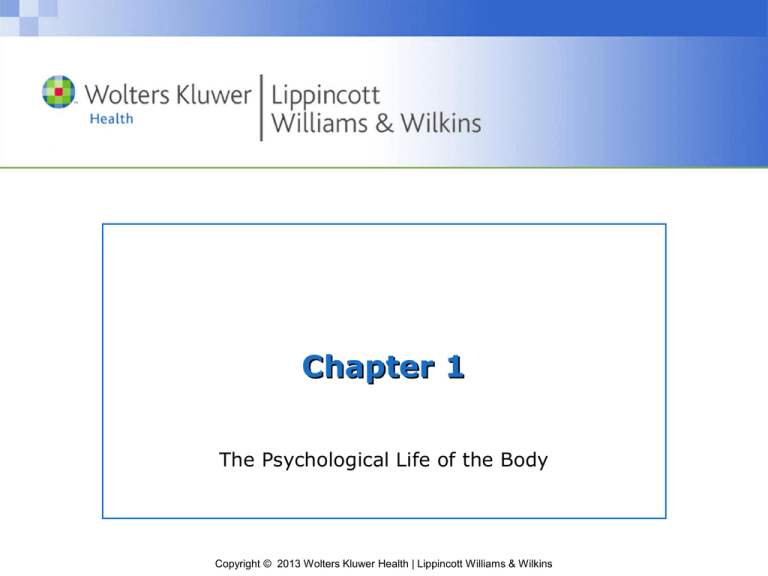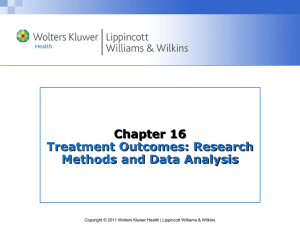tension patterns - Wolters Kluwer Health
advertisement

Chapter 1 The Psychological Life of the Body Copyright © 2013 Wolters Kluwer Health | Lippincott Williams & Wilkins Key Terms • embodied cognition a comprehensive approach to and framework for the study of the mind, elevating the importance of the body in explaining cognitive activities and emphasizing that the body is crucial to mental life; treats cognition as a tool evolved by organisms for coping with their environments • bodymind term describing the unity of body and mind Copyright © 2013 Wolters Kluwer Health | Lippincott Williams & Wilkins Key Terms • intervention any action, verbal or nonverbal, on the part of the therapist that changes the course of a session • bonding the development of a close, interpersonal relationship • attachment a relationship with an emotional connection • attachment theory the psychological theory used to describe the emotional connection between individuals Copyright © 2013 Wolters Kluwer Health | Lippincott Williams & Wilkins Key Terms • paradox of healing although the client consciously desires change, he may also unconsciously dread it and thus resist the process • tension patterns neuromuscular contraction that has settled into a habitual pattern that inhibits the client’s emotional expression and full range of motion • recontraction when the client unconsciously believes that the pattern protects her from intolerable emotions; thus, she will (also unconsciously) attempt to reestablish it session after session Copyright © 2013 Wolters Kluwer Health | Lippincott Williams & Wilkins Key Terms • armoring any chronic pattern of involuntary tension in the body that dampens or blocks emotional expression, alters perception of the outer world or inner psychological world, diminishes or eliminates kinesthetic awareness, and restricts range of motion • emotional release a phenomenon in which a client, during a massage therapy session, begins to spontaneously express emotions, such as sadness, anger, or fear • therapeutic alliance an alliance between the therapist and the client to support the client’s physical and psychological health and progress. In forming a therapeutic alliance, the client agrees and commits himself in some form to contribute his active involvement in the therapeutic process, acknowledging that the therapist cannot undo his tension patterns without his participation Copyright © 2013 Wolters Kluwer Health | Lippincott Williams & Wilkins The Connected Mind and Body • Seeing the mind and body as separate entities has been the predominant viewpoint of psychology from the time of its emergence as a separate field of study until recently • At the same time, others outside the field of psychology have believed in the unified nature of the mind and body • Science is increasingly supporting this view • Recent research has been producing evidence that the mind and body are indivisible Copyright © 2013 Wolters Kluwer Health | Lippincott Williams & Wilkins Studies Supporting the Connection • Kurt Goldstein studied psychological and physical trauma to determine that the nervous system works as a whole • Candace Pert’s studies revealed the biochemical system of emotional communication in the entire body • Antonio Damasio’s studies showed that consciousness is located within the entire body • Discovery of “mirror neurons” and our ability to read and feel others’ emotions • Physical evidence of the connection between the mind and body is shown through the C tactile fibers’ signals to the part of the brain that processes emotion Copyright © 2013 Wolters Kluwer Health | Lippincott Williams & Wilkins Embodied Cognition • The mind and body work together during interactions with others to decode intentions and emotions – Neural circuitry engages in unconscious tasks like mirroring – Seeing a smile or reading the verb “to laugh” activates the facial muscles that make a smile • Jostman: “How we process information is related not just to our brains but to our entire body. We use every system available to us and come to a conclusion and make sense of what’s going on.” Copyright © 2013 Wolters Kluwer Health | Lippincott Williams & Wilkins Psychology and Massage Therapy • The psychological life of the body affects the therapistclient relationship • The client’s need to be touched is related to his or her psychological needs • Listening to the emotional needs of your client will improve your practice • Massage is an intervention in the flow of the bodymind; it is more than physical Copyright © 2013 Wolters Kluwer Health | Lippincott Williams & Wilkins The Development of Touch • Touch is the earliest sensory function to develop • It is the most developed sensory modality among newborns • When a human embryo is under an inch long and less than 2 months old, the skin is already highly developed • The skin and its embedded receptors make up the largest of the sense organs Copyright © 2013 Wolters Kluwer Health | Lippincott Williams & Wilkins The Role of Touch in Survival • Infant mammals must be touched to initiate various physiological functions • The development of child care in America demonstrates the importance of touch – Dr. Luther Emmett Holt’s view that infants should be handled minimally contributed to a 100 percent mortality rate among children under 2 in orphanages – Dr. Fritz Talbot witnessed the power of touch in a German orphanage and led the charge to recognize the importance of touch in the United States – By the late 1920s, the mortality rate had dropped significantly Copyright © 2013 Wolters Kluwer Health | Lippincott Williams & Wilkins The Role of Touch in Growth and Development • Numerous studies show the benefits of extended skin-to-skin contact • Before the age of 2, touch is the primary means by which a parent and child communicate • Very young children are able to recognize the connections between emotions and events and emotions and actions • Attachment theory (the study of emotional connections between individuals) – “Primary object clinging”: a need for intimate contact – Harry Harlow’s analysis of love response in primates • Showed that nurturing touch is more important than feeding and interactive nurturing touch is essential to healthy development Copyright © 2013 Wolters Kluwer Health | Lippincott Williams & Wilkins The Benefits of Massage • Studies show that nurturing touch can help repair damage done by touch deprivation – Infants receiving mechanosensory stimulation averaged 47 percent greater weight gain per day than those who didn’t – Other studies show that touch facilitates growth and development • Touch can relieve pain – Infants who were touched or held during a heel lance procedure cried 82 percent less and had lower heart rates than those who were not touched Copyright © 2013 Wolters Kluwer Health | Lippincott Williams & Wilkins The Role of Touch in Social Interaction • Physical contact conveys intimacy • Touch can influence behavior and response – Various studies show that touch increases helpful response, leads to greater persistence, increases sales rates, affects a person’s impression of another person, encourages compliance and attention, promotes generosity, and so on • In a health setting, touch leads to clients speaking longer with therapists and disclosing more • Emotions are communicated through touch – People can recognize compassion and other emotions in touch even when they can’t see the person touching them • Touch has a calming effect, as evidenced by several studies Copyright © 2013 Wolters Kluwer Health | Lippincott Williams & Wilkins The Role of Touch in Emotional Healing • Touch can change a person’s emotional response and promote healing • Feelings take place in the body as well as in the mind – The body is the vehicle for expression • Touch can disrupt patterns of muscular tension that inhibit emotions – This changes the person’s emotional responses • The massage client has to be ready to have his or her emotional response changed Copyright © 2013 Wolters Kluwer Health | Lippincott Williams & Wilkins The Paradox of Healing • Massage is a requested intervention, but the client may still resist • The client may consciously desire change, but he may unconsciously dread it and resist the process • The client may fear that the core of the self may be wounded if it is exposed to the world • A client who feels threatened may start canceling or forgetting appointments or otherwise similarly “acting out” – In most cases, this is not intentional, and the client may not even be aware of the lack of cooperation • Encountering the paradox of healing does not mean the therapist is doing something wrong Copyright © 2013 Wolters Kluwer Health | Lippincott Williams & Wilkins Tension as Defense • Tension, when employed in the service of psychological defense, is used to protect oneself from emotional pain • A tension pattern is a neuromuscular contraction that has settled into a habitual pattern that inhibits emotional expression and a full range of motion • These emotional blocks fade into the background of a person’s awareness and are only brought into the foreground when there is a triggering event Copyright © 2013 Wolters Kluwer Health | Lippincott Williams & Wilkins Try This Exercise to Explore Tension Patterns • Hold your breath • Notice the tension required to keep holding your breath • Notice the number of muscles needed • Now try breathing while maintaining this tension pattern • This is what happens in chronic tension patterns—the person learns to block emotions or pain and adapts to function with the block, e.g., in this exercise you quickly figured out how to breathe even though you were maintaining a tension pattern Copyright © 2013 Wolters Kluwer Health | Lippincott Williams & Wilkins Recontraction and Armoring • Recontraction occurs when the tension patterns reform after being worked on and presumably cleared • Armoring is indicated by recontraction – A chronic pattern of involuntary tension that blocks emotional expression, alters perception, diminishes kinesthetic awareness, and restricts range of motion – It attempts to undo the effects of massage and reconfigures tension patterns – Armoring is a defense against feeling pleasure • Massage requires surrender Copyright © 2013 Wolters Kluwer Health | Lippincott Williams & Wilkins Emotional Release • Occurs when the client begins to spontaneously express emotions such as sadness, anger, or fear • Release can be dramatic or subtle • Occurs when the pattern of tension has been disrupted – Emotions held by the tension pattern are released, and the outburst results • In many cases, the inhibition of emotion began in the client’s past • Release enables the appropriate expression of previously suppressed emotions Copyright © 2013 Wolters Kluwer Health | Lippincott Williams & Wilkins The Therapeutic Alliance • Encountering emotionally based tension patterns can be surprising and frustrating – Simple application of techniques is not enough to permanently disrupt them • Client must be actively involved in the process – the massage therapist cannot undo the client’s tension patterns without his or her participation – Contributes his or her awareness and commitment to forming the therapeutic alliance • Active participation takes work and learning – When the client finds that the emotions being blocked are tolerable, very often the unconscious mind can more easily let go of the tension pattern Copyright © 2013 Wolters Kluwer Health | Lippincott Williams & Wilkins






